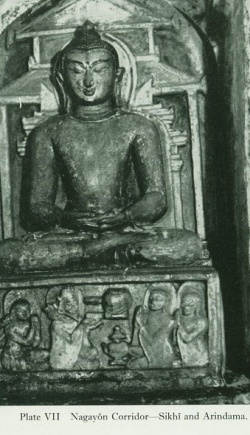Difference between revisions of "Sikhī"
(Created page with "thumb|250px| <poem> Sikhī. The twentieth of the twenty four Buddhas. He was born in the Nisabha pleasance in Arunavatī, his father being the k...") |
|||
| Line 1: | Line 1: | ||
| − | [[File: | + | [[File:Sikhin.5th.prior.buddha.jpg|thumb|250px|]] |
<poem> | <poem> | ||
| − | Sikhī. The twentieth of the twenty four Buddhas. | + | Sikhī. The twentieth of the twenty four [[Buddhas]]. |
He was born in the Nisabha pleasance in Arunavatī, | He was born in the Nisabha pleasance in Arunavatī, | ||
| Line 13: | Line 13: | ||
was given milk rice by the daughter of Piyadassī setthi of Sudassananigama, | was given milk rice by the daughter of Piyadassī setthi of Sudassananigama, | ||
and grass for his seat by Anomadassī. | and grass for his seat by Anomadassī. | ||
| − | His Bodhi was a pundarīka. | + | His [[Bodhi]] was a pundarīka. |
His first sermon was preached in the Migācira pleasaunce near Arunavatī, | His first sermon was preached in the Migācira pleasaunce near Arunavatī, | ||
and his Twin Miracle was performed near Suriyavatī under a campaka tree. | and his Twin Miracle was performed near Suriyavatī under a campaka tree. | ||
| − | The Bodhisatta was Arindama, king of Paribhutta. Abhibhū and Sambhava were his chief disciples among | + | The [[Bodhisatta]] was Arindama, king of Paribhutta. Abhibhū and Sambhava were his chief disciples among [[Monks]], and Akhilā (Makhilā) and Padumā among nuns. |
[[File:Buddh465.jpg|thumb|250px|]] | [[File:Buddh465.jpg|thumb|250px|]] | ||
| − | His | + | His [[Constant]] attendant was Khemankara. |
| − | Among his patrons were Sirivaddha and Canda (Nanda) among men, | + | Among his patrons were Sirivaddha and Canda ([[Nanda]]) among men, |
and Cittā and Suguttā among women. | and Cittā and Suguttā among women. | ||
| − | His | + | His [[Body]] was sixty cubits high, and he lived to the age of seventy thousand years, dying in Dussārāma (Assārāma) in Sīlavatī. |
Over his relics was erected a thūpa three leagues in height | Over his relics was erected a thūpa three leagues in height | ||
(Bu.xxi.; BuA.201ff.; cf. D.ii.7; iii.195f.; J.i.41, 94; DhA.i.69; S.ii.9; Dvy.333). | (Bu.xxi.; BuA.201ff.; cf. D.ii.7; iii.195f.; J.i.41, 94; DhA.i.69; S.ii.9; Dvy.333). | ||
| − | Sikhī Buddha held the Pātimokkha ceremony only once in six years (DhA.iii.236; cf. Sp.i.191). | + | Sikhī [[Buddha]] held the [[Pātimokkha]] ceremony only once in six years (DhA.iii.236; cf. Sp.i.191). |
| − | For a visit paid by him to the Brahma | + | For a visit paid by him to the [[Brahma]] [[World]] see Abhibhū. His name also occurs in the Arunavatī Paritta (q.v.). |
| − | Sikhī Sutta. The process by which Sikhī Buddha, like the other Buddhas, reached Enlightenment. S.iii.9. | + | Sikhī [[Sutta]]. The process by which Sikhī [[Buddha]], like the other [[Buddhas]], reached [[Enlightenment]]. S.iii.9. |
</poem> | </poem> | ||
{{R}} | {{R}} | ||
Revision as of 03:29, 9 May 2013
Sikhī. The twentieth of the twenty four Buddhas.
He was born in the Nisabha pleasance in Arunavatī,
his father being the khattiya Aruna (Arunavā) and
his mother Pabhāvatī.
He was so named because his unhīsa stood up like a flame (sikhā).
For seven thousand years he lived in the household in three palaces - Sucanda, Giri, Vahana (BuA.p.201 calls them Sucanda kasiri, Giriyasa and Nārivasabha) -
his wife being Sabbakāmā and his son Atula.
He left home on an elephant,
practised austerities for eight months,
was given milk rice by the daughter of Piyadassī setthi of Sudassananigama,
and grass for his seat by Anomadassī.
His Bodhi was a pundarīka.
His first sermon was preached in the Migācira pleasaunce near Arunavatī,
and his Twin Miracle was performed near Suriyavatī under a campaka tree.
The Bodhisatta was Arindama, king of Paribhutta. Abhibhū and Sambhava were his chief disciples among Monks, and Akhilā (Makhilā) and Padumā among nuns.
His Constant attendant was Khemankara.
Among his patrons were Sirivaddha and Canda (Nanda) among men,
and Cittā and Suguttā among women.
His Body was sixty cubits high, and he lived to the age of seventy thousand years, dying in Dussārāma (Assārāma) in Sīlavatī.
Over his relics was erected a thūpa three leagues in height
(Bu.xxi.; BuA.201ff.; cf. D.ii.7; iii.195f.; J.i.41, 94; DhA.i.69; S.ii.9; Dvy.333).
Sikhī Buddha held the Pātimokkha ceremony only once in six years (DhA.iii.236; cf. Sp.i.191).
For a visit paid by him to the Brahma World see Abhibhū. His name also occurs in the Arunavatī Paritta (q.v.).
Sikhī Sutta. The process by which Sikhī Buddha, like the other Buddhas, reached Enlightenment. S.iii.9.

